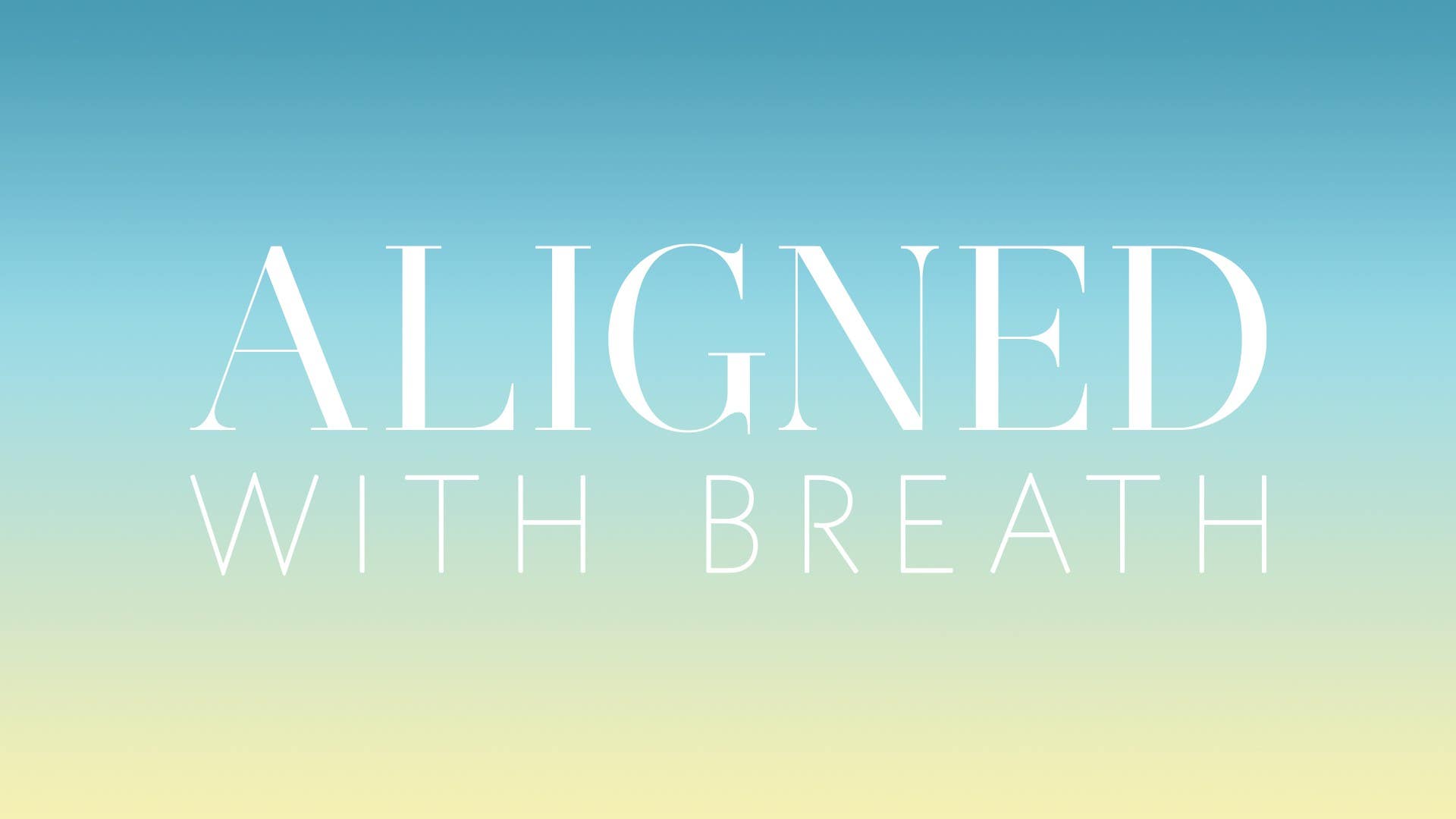Description
About This Video
Transcript
Read Full Transcript
Hello, welcome back. In this second season of Aligned with Breath, I've had different practices that have had different qualities of energy, some really strong. This particular practice is going to be very soft and quiet. It would be a great practice to do before bed or on days when you feel like you don't quite have the energy to get up and do a bunch of dog poses and other things. Personally, I love to practice this way. I love to just get quiet and internal and be really soft in the body. We're going to start sitting in Sukhasana. You want to sit up on a folded blanket or some prop where your pelvis is slightly elevated unless your hips are the kind of hips that let your thighs just completely drop to the ground. In Sukhasana, we cross right at the center of the shins, and the feet are more or less underneath the knees versus Siddhasana where the thighs are wider and the feet are more crossed in the center. This is a little bit of an easier position on the hips. We're actually going to go for hip opening today, so drawing the thighs in, cross to the shins will get us a little bit more into the external rotators. Then from here, just find a big length of the spine. Bring your hands onto the floor in front of you. Feel the floor underneath your hands. Let there be a sweet quality there. Then tip your pelvis a little bit more so the pubic bone will roll down towards the tailbone. Just listen to your body. Maybe walk forward more. Maybe stop. Sometimes I think of it as like a green light, yellow light, red light situation. I want to just pause when I get to the yellow light, not speed through. Just listening in, softening the spine. The spine, I want it soft but not collapsed. I don't want to collapse down and into myself. I want my spine to be a long trajectory from tail to head like a portobello mushroom. Then walk your hands over to the right, coming into a diagonal stretch. Release, relax down through the left hip as you reach the left arm long. Maybe you crawl the left fingertips a little further only if your body says go. Otherwise, just pause, breathe, settle. Then we're going to stay on the diagonal as we sit up so you'll end up in a twist. Root the sitting bones. Engage a little of the belly. Come up left hand to right leg, right fingertips behind you and just again a gentle twist being guided by the breath. Perhaps letting the pauses at the end of the exhalations just be a little bit longer, making space for the next inhale to arrive when it does. Okay, we'll come back to the center and keep the spine long as you come to the center. Lean back, shift the crossing of your legs, right at the center of the shin. Breathe in, find your length. Breathe out, the hands mindfully meet the floor. Then with an inhale, find a little more space through the spine and maybe you go forward a little more, maybe not. See how honest you can be as you let your, you know, our brains tend to be a little bossy in general. So try not to let your bossy brain decide where you go. How much can you listen in to the hips, to the spine, to the breath to guide you to the perfect place. Walk to the left, drawing the right arm up out on the diagonal, feeling how shifting the pose just that much affects the feeling tone. Finishing the exhale, pausing at the exhale to give space for the next inhale. And then with your next inhale, come up sitting on the diagonal, right hand to left leg, left hand behind you and use your breath to guide you pausing a little bit extra kind of lingering in that space after the exhale to make space, perfect way for the inhale. And then again, without any compression, unwind, spiral up with the spine like an old fashioned barbershop pole. Lean back, bring the soles of your feet together in Baddha Konasana. Hold on to your toes, your arches, wherever your hands fall.
And then pull back a little on your legs, lift your chest and let your thighs drop down. I'm going to keep the spine upright for right now and just feel the soft right half of the brain over a wide sinuses and cheekbone. Feel a line directly down through your right lung into the descent of your right sitting bone. Let the right side draw. Second side, left half of the brain softens down to kind of a wide cheekbone sinus area. Draw softens down through the left lung into the left sitting bone and let your left thigh drop heavily. Take a smooth long inhale and then exhale. Pause at the end of the exhale. So we're going to move into a pose that was invented when my son was about one and a half. I call it Finasana. His name is Fin. One foot goes right in front of the other foot. It's like Baddha Konasana, except one foot is directly in front of the other foot. And then come forward. Kind of try to remember what it was like to have a one and a half year old gooey, not walking hips. You can rock a little bit from side to side. For some bodies, that's a really good way to enter into the pose. Other people prefer stillness. Again, you do as you see fit. That was the Buddha I just quoted. After the Buddha did his teachings, he would say, okay, now with this information, go out and do as you see fit. Okay. From Finasana, kind of a soft version of Baddha Konasana, come up. I'm going to slide off of my blanket here. You can decide if you want to keep your blanket or not. I'm going to pull the left leg more to the midline. And then if half lotus is in your cards and there's no problem for the knee, I'm going to lift the right foot, let the right thigh drop heavily and pull the right foot into half lotus. You're also welcome to just leave your right foot onto the floor right in front of your left shin. Never force lotus pose because it's easy to kind of bust into the knee. So if there's any sensation there, you just leave your foot on the floor and no problem. Left heel comes into the left side of the belly. If you're doing half lotus and the right thigh can drop down and then twist to the right. Bring your right hand behind you. If your foot is in lotus and you want to try to wrap your right hand behind you, find your right big toe. You can do that. If you do that, the thumb slides right in between the big toe and the second toe. And then root down through your sitting bones.
Let the legs be heavy. So it's an anchored feeling. And then again, align yourself with the breath and attempting not to rush in to the next inhale instead lingering in the pauses. And then unwind without shrinking at all. And you're going to recline back. So roll back onto your back, keeping your legs in the same position. If they're not in lotus, they can be in cross-legged position. Now hold onto your feet and let your knees go down on away from you. Reclined half lotus or a seated cross-legged reclined pose. If you love lotus and it's easily in your practice, you can slide the left foot up into full lotus. And then again, feel in. Let your attention sail right around your body. And then from here, let go of your feet. Just widen your thighs so your feet end up in bada canasana. Take a breath in. Exhale. Use the muscles of the legs to draw the feet together and then extend your legs forward. Now after all that external rotation, the legs are now parallel. Squeeze them to the midline. Cultivate a little strength in the parallelness of the legs to sort of counter the external rotation. Create some stability there. Slide your hands behind your head. Take a breath in. Exhale. Lift your head. See your toes. Squeeze the legs in towards each other. Breathe in. Exhale. Lift your toenails to the level of your eyes.
Arda Navasana. Inhale. Exhale. Reach your arms forward. Come up into Navasana. It's fine to hold onto the backs of the knees. It's fine to have the knees bent, but try to lift the sides of the collarbones and open the chest. And then sit up. Come back into Finasana. Second side. So we'll bring the left foot in front of the right foot. The feet just in a straight line. Take a breath in, finding the length of the spine. And exhale coming forward. And again, if it's helpful to rock a little from side to side, you can do that. Kind of an oceanic quality to it. If stillness is better for you, just drop into stillness. Letting there be the little pauses at the end of the exhalation. And then you welcome in the next exhale. When your body is ready, it will take the breath. With your next inhalation, come up to sit. Pull the right leg a little bit more in towards your midline. Scoop the left foot up and see how it goes with the entry into Lotus. Let the left thigh be heavy. Try not to grip it all in the left groin. The left thigh is heavy. And then left knee bend. You can pull your foot in to have Lotus. Check in with that. Another option you could always try if there's just a little discomfort is to put a prop underneath your knee. I'm going to turn to the left. Bring the left hand behind you or the left hand can reach around and find the left big toe. It gets confusing because it's visiting the right side of the body, but it's still the left big toe. Bring the back of your hand to your right leg. Widen any amount across the chest as you release and relax the base of the pose into the ground. Breathing in. Breathing out and letting there be the pause. And then unwind. And again, recline straight back. Either cross-legged holding onto the feet or half Lotus, full Lotus, hold your feet and let the legs go down. And you want to feel a real active lengthening of the thighs moving towards knees. Let the thighs drop and be heavy as well. And as best you can settle down through the front of the diaphragm, attempting to let the diaphragm be in its neutral position. Slide your legs open to Supta Baddha Konasana. Supta is reclined. Baddha is bound. Kona is angle. So reclined bound angle. Take a breath in here. Exhale, knees together. Straighten your legs. Squeeze the legs in. Very different quality now, just for a few moments. Take a breath in. Exhale, hands behind your head. Use your hands to lift your head. Lift your head, lift your shoulder blades. Take a breath in. With long legs squeezing together like you have one leg. Lift the two legs. We're pretending like they're one leg. Up. Toenails and eyeballs at the same level. Take a breath in. Exhale, Navasana. Navasana, Navasana. And then release and open your legs into Upavishta Konasana, which is this straddle position. And the legs are not too wide. There's another pose called Sama Konasana, where the legs go straight to the side. Upavishta, they're on a diagonal. Bring your arms behind you and check in with your feet and your knees. They like to kind of distort often. See if you can have your kneecaps pointing straight up, ankles clear, toes pointing straight up. I feel like with my legs, and I think it's common, I have to be like a stern babysitter or they just go on their own journeys. Knees up, toes up. And then walk your hands behind you if they're not already, widen across the chest, and close your eyes and just feel this pose with your expansive legs, your long spine, the sense organs soft, and the breath smooth. Okay. Take your right hand to your inner right knee. Keep the right thigh wide as you pull the right heel right into the center of the pelvis. Parvita Janu Sureshasana, revolved head to knee pose. Left hand slides down the left foot. Keep your palm facing up. If your hand happens to make it to your arch, you do a strong external rotation of the arm and hold on to the arch with the little finger facing up, kind of an interesting feeling if you're not used to it. And then reach your right arm up and over your right ear. And you can, maybe the hands both come to the feet, but that is completely unnecessary. Just go anywhere along that side, side plane, and breathe and listen. And remember to do a little extra pause at the end of the exhalations. Okay. And then from here, we're going to slowly smoothly come up, lean a little bit over to your right side, bend the left knee, bringing the left heel right into the sitting bone, and then turn that leg into Virasana. Virasana, if you're not happy with it, the leg can stay externally rotated. Right leg can stay here or you can lean back, scoop the foot, drop the thigh, pull it into half lotus. We twist. Twist to the right, the left back of the hand comes to the right leg, right hand comes behind your back. So pretty much we can find our way into this practice, no matter how many yoga classes we've done. It's a practice that can go across levels, but don't, don't force anything. Okay. And then from here, release your hands.
Just pull the right leg off of the left leg. And this leg is in Baddha Konasana, this leg is in right leg is in Baddha Konasana, left leg is in Virasana. And then just fold forward. This one usually feels pretty, pretty good. You can stack your hands. Don't worry about kind of staying rooted or grounded in the pelvis. Just let there be an easy, relaxed quality to the legs, to the spine, to the head, to the brain, the breath, the thoughts. And then push into your hands. Come up, flip the left, keep the left knee bent. Flip it back into Baddha Konasana. From here, lean back, open the legs back into Upavishta Konasana. This time, check knees, check feet, and then bring your hands forward. And again, just any amount coming forward. You're always welcome to put a prop underneath your forehead in this semi-restorative practice. Sometimes I like to just bend my elbows and let the forehead rest into the hands, reminding the front lobes of the brain to be soft. Front of the brain is where creative thought, imagination, thinking happens, which is wonderful. We want that, but we don't necessarily want that right now. Giving ourself a little respite from all of the intelligence of the brain and dropping into the intelligence of the body. Come up. Left hand helps the left thigh stay wide and pull the left heel right into the center of the pelvis. Back of the right hand slides down the right leg. Just rest the back of your hand onto the ground, or if you reach, hold onto the foot. Left arm comes up and over. Just listen, listen, listen. A couple of years ago, I ordered some Converse tennis shoes and I did a custom order so I could pick my laces and colors and they let me pick one word to put on the back of the stripe, on the back of the shoes. I sort of pondered what word I wanted to do and I settled on the word listen. From here, come up, lean to the left. The safest way to deal with the knees is to have the knee bent when in transition.
Bend the knee deeply, shift it into Virasana, stay here, or hold onto the left foot, draw it up. Bring into Half Lotus and then twisting to the left. Releasing any amount down through the sitting bones, down through the legs, always finding our anchors, finding our roots, is grounding to the nervous system. Even just feeling your feet on the ground if you're standing, always anchoring down. From the anchors, we get to lift and ascend up. Alright, and then come back to the center and slide your left leg off and then here we have our half external, half internal pose with the legs and the spine comes forward. Feeling the breath slide into the skin underneath the back of the body. Slide your hands down, press down to come up, keeping the right knee bent, flip that leg back into Baddha Konasana, use your hands to bring your knees up. Okay, we're going to finish this quiet practice with a restorative pose that I really like and it's kind of a combination of two restorative poses. I put them together so it's going to be a little, sometimes a little teeny bit tricky to get into. I'm going to go through it slowly and if you've done this practice before and you know it, you can just roll right into it. If you don't happen to have these props, you can do the pose just lying where it's going to be a version of Supta Baddha Konasana, you can just lie down onto your back with the soles of the feet together and the knees apart. So I put a block here to extend the bolster. I have my belt looped in a quite large loop. I'm sitting on the end of the bolster and then I take the belt all the way over my head, all the way to my low back. I'm going to have the belt around your low back and then I'm going to bring the soles of your feet together and slide the belt over the feet and so they're on the outer edge of the feet. From there you bring the belt and slide it down so it's low on your back and then tighten the belt so that your feet, you don't want to bring them in too tight because as you lie back they'll actually cinch in a little bit more but the belt holds the legs in. From there I'm going to lie back onto my bolster and I want my shoulder blades to be on the bolster but my shoulders falling right down to the ground. My block slid away. So the shoulders down to the ground, chest open so there's like a bridge pose, a shoulder stand feeling in the throat and if you have a blanket you can just rest it over your belly and the arms rest out to the side. If there's any discomfort or pain in your low back, if you can figure out how to get your feet lifted a little more, put another prop underneath your feet, that usually takes out any strain in the low back. You can also welcome just to move the bolster. There's many, many ways to do all of these poses. They're not one size fits all so find your way in. There should however be a moment when you can find kind of a sweet spot where you feel your whole system kind of unwinding into stillness. When you find your comfortable place, tap back into the breath. Remembering to pause just a little bit extra at the end of the exhalation. Instead of the brain deciding when to pull in the next breath, your body knows. Your body knows and when it's time the body will take in the next breath. You can welcome it and watch it fill the channels of the chest, the belly, the legs, the arms. Watch exhalation softening down more completely over the props. You're welcome to stay here longer. If you feel ready to come out, you will pull the legs up and slip the feet out of the strap and then lift up and pull the strap off of your body. Then lift your pelvis up and push the bolster in the direction of your feet. Turn the bolster so that's going to go underneath the knees for a shavasana. If you have any blanket or something you'd like to put over your forehead, once again put a little weight on the front of the brain, a little darkness over the eyes, you can do that. The arms rest comfortably to the sides for shavasana. Here in shavasana you can let the breath dissolve to a neutral breath, letting the body now make all the decisions about how the breath goes.
Aligned With Breath
Comments
You need to be a subscriber to post a comment.
Please Log In or Create an Account to start your free trial.




















